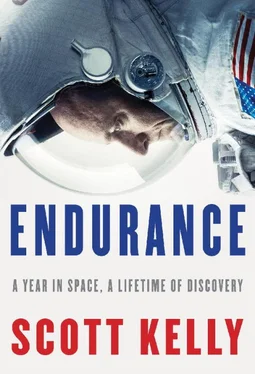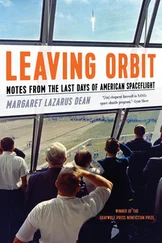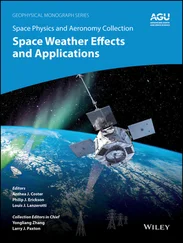Once our training was in full swing, we spent a lot of time in simulators. Running simulated missions is the only way for astronauts to get hundreds of hours of experience doing something that in reality we would get to do only a few times. The simulations re-created the experience as closely as possible—same screens, switches, and buttons; same uncomfortable metal-framed seats, same headsets, and same thick procedure books. The simulation supervisors devised fiendish scenarios for us to work through, such as multiple interrelated systems failing while other systems continued working just fine, though their sensors might erroneously report they had failed too. We practiced solving problems quickly. Often the simulations were designed so that one of us would be barraged with problems to test how we worked together as a team.
About halfway through our training, we were in a simulator dealing with a complex failure—all the cooling systems had gone down at once. Those controls were all on the left side of the cockpit, where the commander, Curt, was sitting. He was hit with one malfunction after another, but because he was so talented and experienced, he was able to identify and focus on the most critical issue. Simultaneously, a computer failed. This would normally be his responsibility too, but because I wasn’t as busy and could reach his keyboard myself, I decided to fix it for him by switching out the backup for the primary system. I typed in the commands while Curt’s head was still buried in cooling system problems. Item 16, execute, I typed.
A few minutes later, Curt got through his work with the cooling system. He looked at the display and saw that the computer failure had disappeared. He looked confused.
“What happened to the port failure on FF One?”
“Oh, I port-moded it for you,” I answered. As I spoke, I sensed this was not the answer he wanted to hear.
“You did what ?”
“I port-moded it.”
A second went by—and then Curt turned toward me, which was difficult to do wearing a pressure suit while strapped tightly into his seat. He punched me on the arm as hard as he could.
“Don’t ever do that again!” he shouted.
“Ah, okay,” I said. “I won’t ever do that again.”
He’d made his point, and though I didn’t agree with his method, I appreciated his directness. I never touched any buttons or switches on his side of the cockpit again without his explicit approval.
—
EILEEN COLLINS BECAME the first woman to command a space shuttle mission, on Columbia, in July 1999. Once that flight got off the ground, we would become the prime crew, our launch date set for October 14, 1999. But there was a problem on Columbia during ascent. An electrical short disabled the center engine’s digital control unit. The engine continued to operate on its backup—a case of NASA’s redundancy saving the crew from what would have been a very risky attempt at an abort—but something had gone seriously wrong, and NASA needed to find out what it was before flying again. The Columbia mission was cut short, and when the shuttle was safely back on the ground, an investigation ensued.
It was revealed that wiring in the payload bay had been chafing against an exposed screw, a good reminder to everyone of how little it can take to cause a disaster. Further inspections revealed deteriorating wiring throughout the space shuttle fleet that would need to be addressed before any of the shuttles could fly again. That caused a delay in our launch date to November 19. As inspections and repairs to the wiring dragged on, we were delayed further, to December 2, then to December 6.
These delays were frustrating for everyone. It was mentally draining to keep working toward a date that slipped away, then bring our full energy to the next announced date. The December 6 launch date didn’t change as November went by, and we grew hopeful. We celebrated Thanksgiving with our families, then the next day we said our good-byes and went into quarantine. NASA’s quarantines were a bit different from the Russians’—they were more stringent in some ways and less stringent in others—but the underlying concept was the same: to isolate space travelers from germs before a launch in order to decrease the chances of us getting sick in space.
There were crew quarters at both Houston and the Cape, very similar in style to each other, where quarantined astronauts live. In both places, the crew quarters were more like an office than a hotel—spartan accommodations. The time when the shuttle was to rendezvous with the telescope would be in the middle of the night Florida time, so we had to adjust our sleep schedule significantly. In order to help us make the adjustment, the crew quarters had few windows, and the lights were kept glaringly bright during our waking hours. There were cooks to make us food and a gym to work out in.
We didn’t have a great deal to do once we were in quarantine—we had our checklists (about five feet tall when stacked on one another) to review. We had some of the spacewalking hardware and photography equipment to familiarize ourselves with. We had to sign crew photos to hand out to people who worked on the mission, at least a thousand of them. At the end of our workday, which was actually in the morning, we watched movies together.
While we were in quarantine, our launch date changed again, from December 6 to December 11. It was mildly annoying to know I had spent four days in quarantine that I could have spent at home, but we all understood that delays were part of spaceflight. Then we were delayed again, to December 16. By the morning of the sixteenth, we had been in quarantine for twenty days and were getting tired of it. We were ready to go to space or go home. Then the launch was scrubbed. Inspectors had found a possible problem with a weld in the external tank. Workers needed a day to make sure the issue had been resolved, so we were delayed to December 17.
That morning, I woke up and looked at the weather forecast. There would be a low cloud ceiling, rain, and possibly even lightning. The prediction of weather favorable for launch was only 20 percent go, not very good odds, but the weather in Central Florida could change quickly, so the countdown continued. Workers began filling the external tank, a process that takes hours. We got suited up and headed out to the launchpad. The countdown still continued; it seemed we might finally be going to space. We got strapped into our seats and started preparing the space shuttle to launch, the countdown continuing toward our planned liftoff time of 8:47 p.m. There are a few “holds” built into the countdown—points where extra time has been allowed so we can stop the clock and make sure everything is being done right without being rushed. One of these holds is at T-minus nine minutes, and it’s the last chance to review all the factors that go into deciding whether we are “go” or not. We kept at the T-minus nine hold for a long time, up to our planned launch time and past it. At 8:52 p.m., the launch director made the decision to scrub due to weather. We would try again the next day.
On December 18, we scrubbed again, this time without suiting up. At this point we had been in quarantine twenty-two days. If we’d known from the start how many delays were in our future, we would have gone back to Houston to do some refresher training in the simulators and see our families. Because I was launching for the first time, I had invited practically everyone I knew to come to Florida, along with their friends, about eight hundred people in all, and with every delay the group got smaller as people changed their travel plans. The morning of each launch attempt, friends and family would call and ask, “What are the odds you’re going to launch today?” I understood their impatience, but I never knew what to tell them. Eventually, I started to just say, “Fifty-fifty. Either we’ll launch today or we won’t.”
Читать дальше












